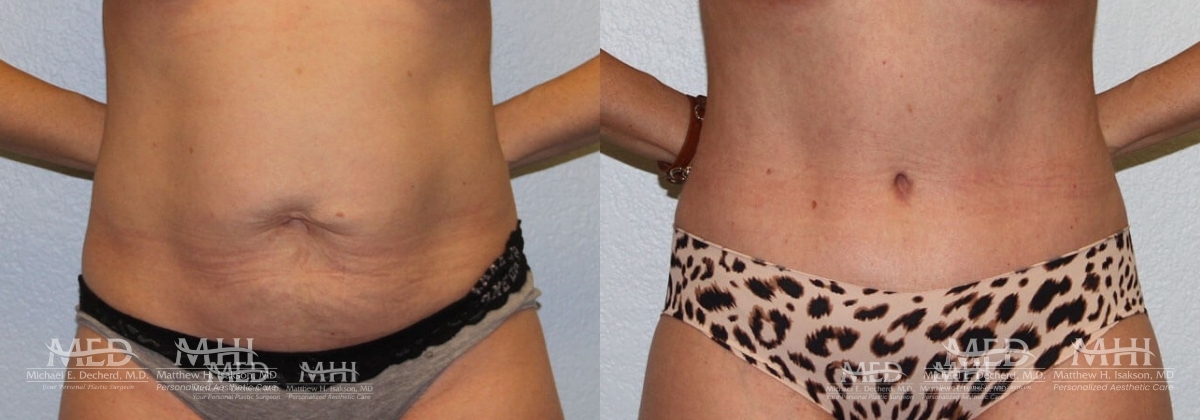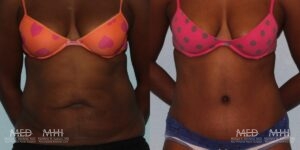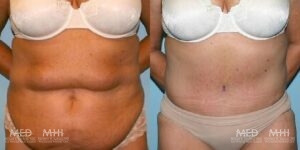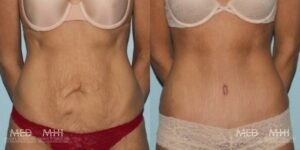100+ Five Star Reviews
Tummy Tuck Specialists In San Antonio

Years Of Experience
Cases Performed
Call (210) 495-4100 today to schedule your consultation!
Request Consultation
Eliminate Sagging Skin
Safely remove excess skin & stubborn fat for a more toned core.
Regain Your Confidence
Wear the clothes you want again with a natural tummy tuck procedure.
Reverse The Effects Of Weight Loss
Reverse the adverse effects of pregnancy or drastic weight loss.
Tummy Tuck Before & After Gallery
*Individual Results May Vary
Tummy Tuck At San Antonio Plastic Surgery Institute
Tummy tuck, also known as abdominoplasty, is an operation that removes excess skin and fat from the tummy while also tightening the underlying muscles. Dr. Michael E. Decherd and Dr. Matthew H. Isakson perform countless tummy tuck surgeries each year and create beautiful results for women. Patients that choose us for tummy tuck surgery can walk away with a firmer, flatter abdomen and a slimmer waist. This surgery is often combined with other procedures, such as a breast lift and liposuction. These are popular combinations for women, especially those who have completed a massive weight loss or those who have experienced pregnancy.
Meet Dr. Matthew H. Isakson
Dr. Matthew H. Isakson is a board-certified plastic surgeon with specialized fellowship training and extensive experience in aesthetic surgery. He specializes exclusively in aesthetic surgery of the face, breast and body with a focus on mommy makeover surgery, abdominoplasty, liposuction, breast augmentation, breast lift, fat transfer to breast, buttocks and labia, labiaplasty, gynecomastia as well as any body contouring procedures related to weight loss.
- Board certified by the American Board of Plastic Surgery
- Active member in the American Society of Plastic Surgery
- Active member in The Aesthetic Society

Types Of Tummy Tucks
Dr. Michael E. Decherd and Dr. Matthew H. Isakson tailor each tummy tuck procedure to the needs of their patients. Some patients will require larger incisions, and a larger section of skin to remove. The procedure will also be determined by how loose the abdominal muscles are and how much tightening is needed. They will also take into consideration the overall aesthetic concerns and goals of the patient and then choose the technique that will garner the best results. Dr. Michael E. Decherd and Dr. Matthew H. Isakson offer several approaches:
Mini Tummy Tuck
Most patients receiving a tummy tuck have excess skin to remove from the abdomen. This tendency may lead women who have no excess skin to think that a tummy tuck cannot tighten their abdomens, a common concern after having children. However, the mini tummy tuck procedure is a tummy tuck designed for people who have no excess skin above the belly button, who are at a stable weight, and who need help tightening the abdominal wall. This procedure tightens the abdominal muscles just as a regular tummy tuck would without the additional step of eliminating excess skin or removing stubborn fat deposits.
Skinny Tummy Tuck
Crafted specifically for Athletic women, our “Skinny Tummy Tuck” falls between a traditional abdominoplasty and a mini tummy tuck. Athletic body types, while lean, may still require skin and muscle tightening, especially after weight loss or pregnancy.
Full Tummy Tuck
A full tummy tuck is the traditional abdominoplasty approach for most men and women. This body contouring procedure is for those who have a moderate amount of excess skin to remove, as well as abdominal fascia that are stretched and loose. This surgery is most common among women after pregnancy. During a full tummy tuck, the incision generally extends from hip to hip. This allows for a greater amount of skin to be removed. Liposuction is usually incorporated to remove excess pockets of fat. The internal muscles are tightened and secured. In some cases, the belly button can be repositioned.
Extended Tummy Tuck
Patients that loose a significant amount of weight usually battle loose skin within the abdominal area. The only way to correct this skin deformity is with an extended tummy tuck. This surgery addresses loose skin and fat in the abdomen, and can reach as far as the hips and flanks. During the extended tummy tuck, the belly button is often repositioned so that is looks natural.
Fleur-de-lis Tummy Tuck
We may recommend a fleur-de-lis tummy tuck for those with significant weight loss and excess skin. This procedure addresses both the upper and low abdominal area by removing skin both horizontally and vertically with two separate scars.
Tummy Tuck Surgical Technique
The goal of a tummy tuck, also known as abdominoplasty, is twofold: we want to remove excess skin and fat from the lower abdomen, and we want to tighten the internal wall muscles that have been stretched apart from a variety of causes including pregnancy, weight loss, or congenital formation. To do this, our surgeons will trim away and remove excess skin, pull the rest of the tummy skin tight, and suture the widened muscles/fascia together in the midline.






